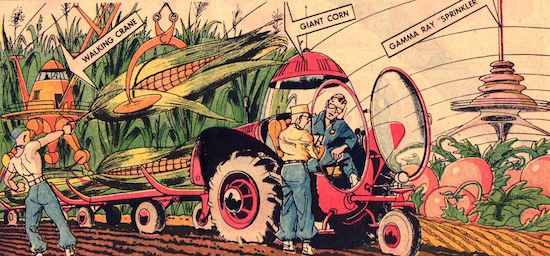Super-Sized Food of the Future
How do you eat an eight-foot-long ear of corn?
/https://tf-cmsv2-smithsonianmag-media.s3.amazonaws.com/filer/201203091051001961-April-9-CTWT-470x251.jpg)
We often associate food futurism with the concept of meal pills. But another popular prediction from the “freaky science” file of retro-futurism involved gigantic fruits and vegetables. (And not just Great Pumpkins, such as the ones that competitive growers are creating today.)
The December, 1900 issue of Ladies’ Home Journal featured a fascinating article titled “What May Happen in the Next Hundred Years” by John Elfreth Watkins, Jr. in which he predicts that super-sized crops would find their way to American dinner tables in the year 2000.
Strawberries as Large as Apples will be eaten by our great-great-grandchildren for their Christmas dinners a hundred years hence. Raspberries and blackberries will be as large. One will suffice for the fruit course of each person. Strawberries and cranberries will be grown upon tall bushes. Cranberries, gooseberries and currants will be as large as oranges. One cantaloup will supply an entire family. Melons, cherries, grapes, plums, apples, pears, peaches and all berries will be seedless. Figs will be cultivated over the entire United States.
Peas as Large as Beets. Peas and beans will be as larges as beets are today. Sugar cane will produce twice as much sugar as the sugar beet now does. Cane will once more be the chief source of our sugar supply.
Arthur Radebaugh’s Sunday comic strip “Closer Than We Think” predicted gigantic food a few times during its run from 1958 until 1963.
The April 9, 1961 edition of “Closer Than We Think” envisioned a highly automated factory farm of the future and showed a laboratory technician hard at work injecting enormous tomatoes with what we can only guess is a synthetic growth hormone.

Colossal crops of the future in the Sunday comic "Closer Than We Think" (January 28, 1962)
The January 28, 1962 edition of Radebaugh’s strip showed off the farm of the future with incredibly large ears of corn being loaded onto the back of a tractor (see image at top of page). I’m not even sure how one would go about eating corn on the cob that appears to be 8 feet long.
COLOSSAL CROPS — In addition to dire threats of destruction, the atomic age has also produced many brighter horizons for mankind’s future. One such happy prospect is the use of radiation to create more uniform and dependable crops that will end famine everywhere in the world.
Gamma ray fields now operating on the east coast point to a day when crops will grow to giant size, vastly enlarging yield per acre. These super-plants will be disease and insect resistant — more tender and tasty — and controllable as to ripening time. Seasonal vegetables like corn will be available fresh nearly everywhere for most of the year instead of only a month or so.
It’s interesting to note that opening line, “In addition to dire threats of destruction,” before the strip explains the wondrous advances in food technology that are in store. Too often we can romanticize past visions of the future, believing that people of a certain era were of one mind. It’s important to remember that even during the Golden Age of American Futurism, there was always the looming threat of nuclear war.
/https://tf-cmsv2-smithsonianmag-media.s3.amazonaws.com/accounts/headshot/matt-novak-240.jpg)
/https://tf-cmsv2-smithsonianmag-media.s3.amazonaws.com/accounts/headshot/matt-novak-240.jpg)